Charts of the Week
Current economic trends from 26 to 30 April 2021: registered unemployment, traffic of electronically tolled vehicles, electricity consumption, consumer prices and other charts
At the end of April, registered unemployment declined further and approached pre-epidemic levels. In most weeks of April, electricity consumption and freight traffic on Slovenian motorways were close to or higher than in the same weeks of the pre-crisis year, which indicates favourable developments in industrial production. With the relaxation of some containment measures, in February, recovery also started in service activities, some of which nevertheless remain strongly affected. In February, turnover increased in most market services, including accommodation and services activities. With the opening of all non-food shops, turnover also rose notably in trade; according to preliminary data, growth also continued in March. Consumer price growth strengthened significantly in April, mainly on account of year-on-year higher prices of energy due to the base effect.
Registered unemployment, April 2021
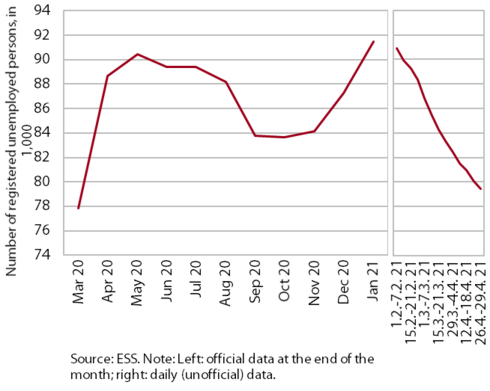
The number of registered unemployed persons fell further at the end of April. Following the increases in the number of unemployed in December and January, which, amid the retention of intervention measures, did not differ much from seasonal increases in the same period of previous years, the number of unemployed dropped from February to April. On 29 April, 79,368 persons were unemployed according to ESS unofficial (daily) data, which is 4% less than at the end of March and around 10% less than in the same period last year. Compared with the end of April 2019, the number was, however, around 7% higher.
Traffic of electronically tolled vehicles on Slovenian motorways, April 2021
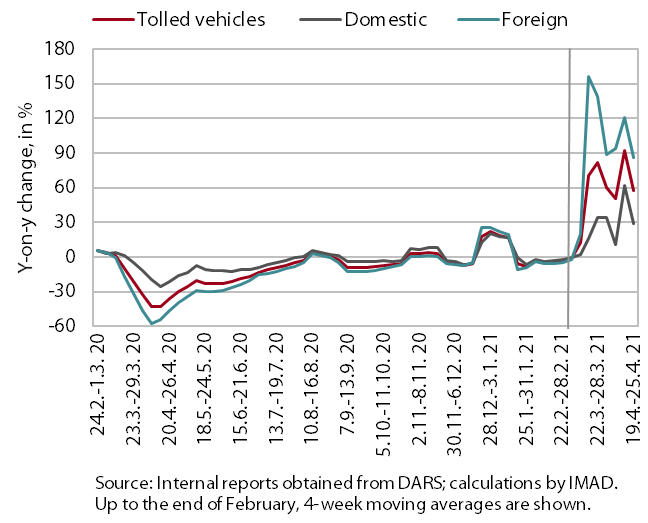
Freight traffic on Slovenian motorways in the fourth week of April was up 58% year on year and up 37% compared with the same period of 2019. Between 19 and 25 April, domestic vehicle traffic was 29% higher and foreign vehicle traffic 86% higher year on year. The strong year-on-year growth was still mainly due to lower traffic in the same period last year as a consequence of containment measures during the first wave of the epidemic, although their limiting effect on industry and road transport already waned slightly. In the fourth week of April, traffic volume rose significantly again, being also significantly higher than in the same period of the pre-crisis year 2019 (in domestic vehicles by 28% and foreign vehicles by 43%), when it had been lower due to one day less because of Easter holidays.
Electricity consumption, April 2021
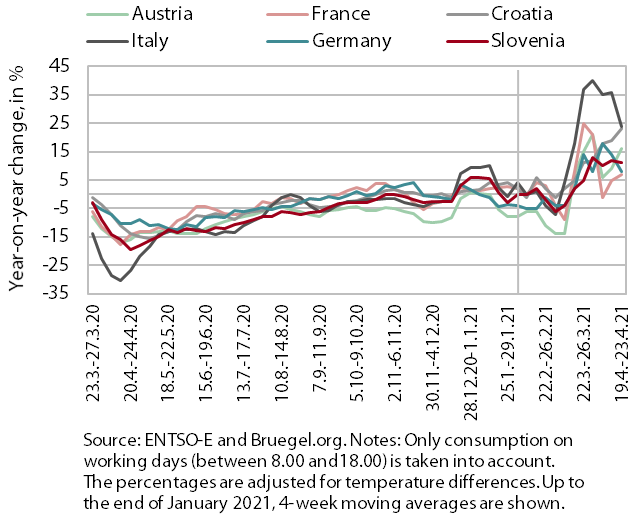
In the week between 19 and 23 April, electricity consumption was 11% higher than in same week of 2020 but 7% lower than in the same week of the pre-crisis year 2019. Despite the additional relaxation of measures, the lag behind the pre-crisis level was larger than one week earlier, when it was 1%; the year-on-year increase was due to the base effect. As a result of the base effect, higher consumption year on year was also recorded in our main trading partners, from 7% in France to 24% in Italy. Compared with the same week of 2019, consumption was down in France and Germany (around 4%), roughly the same in Austria, and up 3% and 14% respectively in Croatia and Italy.
Consumer prices, April 2021
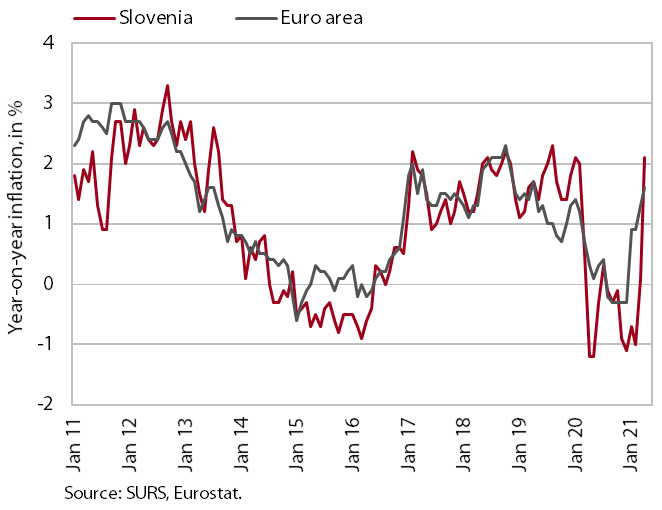
Consumer price growth strengthened considerably in April. The main reason was year-on-year higher energy prices, mainly as a consequence of record low global prices of oil and oil products in April 2020, but also of government measures, i.e. the ordinance that temporarily exempted households and certain small business consumers from paying contributions for electricity consumption. However, after a pronounced decline in the previous two months, prices of semi-durable goods were higher year on year in April (by 0.2%), largely owing to price rises in the clothing and footwear group due to the arrival of new collections, which took place somewhat later than in previous years due to longer-lasting containment measures. Prices of durable goods were also up year on year (by 1.2%), for the first time since August 2019. The year-on-year fall in services prices deepened slightly further in April (to 0.7%); an equal fall was also recorded in the food and non-alcoholic beverages group.
Trade, February 2021
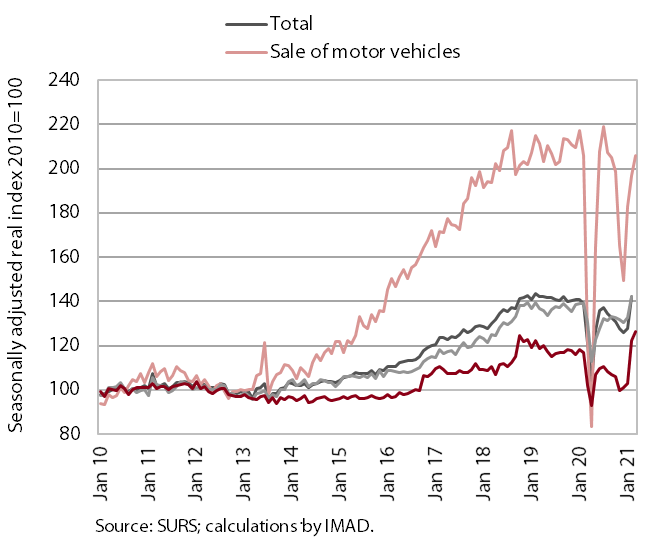
Turnover in trade strengthened significantly with the opening of all non-food stores in February; according to preliminary data, growth also continued in March. With the re-opening of shops and the lifting of the ban on movement between municipalities, turnover increased in all three main segments (the most, almost by a fifth, in retail trade, where non-food sales were up more than a third, partly also due to the compensation of foregone household purchases). Turnover in the sale of motor vehicles was also much higher than in January, although new passenger car sales were still more than a tenth lower year on year. In March, turnover strengthened further in all segments according to preliminary data.
Market services, February 2021
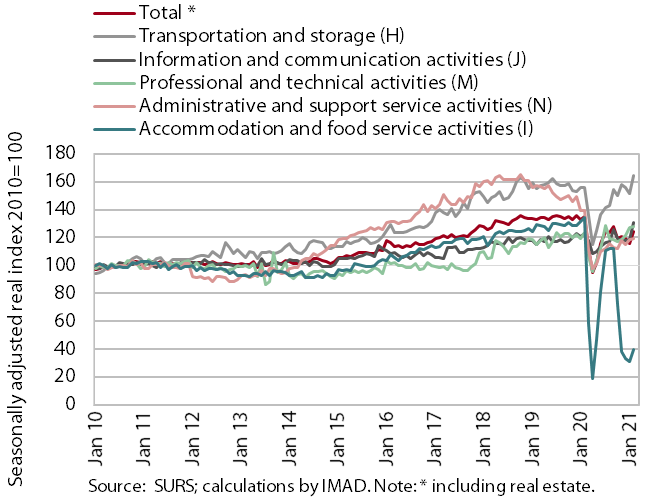
In February, turnover increased in all market services. After falling since October, real turnover strengthened the most in accommodation and food service activities, partly as a consequence of additional explanations regarding the possibility of offering services to legal persons. It also rose strongly in transportation and storage activities, particularly passenger land and freight transport. In information and communication activities, turnover growth accelerated mainly as a consequence of higher turnover in computer services on the domestic market. Turnover in professional and technical activities and in administrative and support service activities remained at the levels achieved in the previous month. Significant lags behind last year’s levels are still recorded in accommodation and food service activities and travel agencies, over 70% and 80% in the first two months, respectively.
